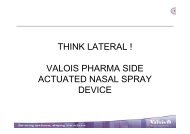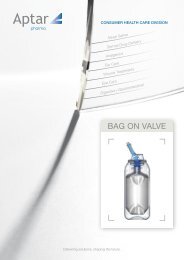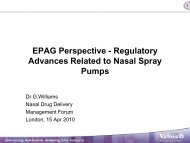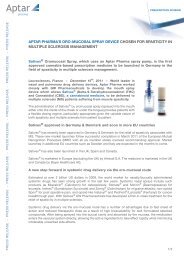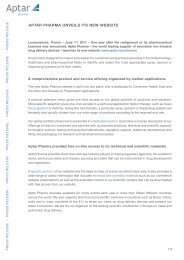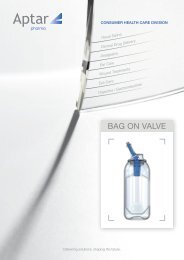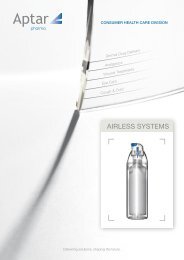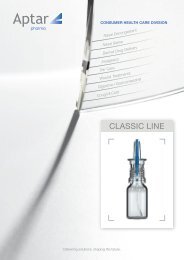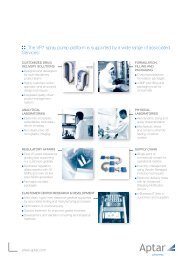Multi-Dose Container for Nasal and Ophthalmic Drugs: A ... - Aptar
Multi-Dose Container for Nasal and Ophthalmic Drugs: A ... - Aptar
Multi-Dose Container for Nasal and Ophthalmic Drugs: A ... - Aptar
You also want an ePaper? Increase the reach of your titles
YUMPU automatically turns print PDFs into web optimized ePapers that Google loves.
<strong>Multi</strong>-<strong>Dose</strong> <strong>Container</strong> <strong>for</strong> <strong>Nasal</strong> <strong>and</strong> <strong>Ophthalmic</strong> <strong>Drugs</strong>: A Preservative Free Future 519<br />
<strong>for</strong>mulation, e.g. chloride ions <strong>and</strong> <strong>for</strong>m micro-precipitations. This effect may be overlooked<br />
because it is most relevant <strong>for</strong> spans of 6-12 hours between individual actuations which are<br />
not routinely tested during development.<br />
Picture 4. Examples <strong>for</strong> ophthalmic devices using the oligodynamic effects of silver in<br />
combination with other measures like collapsing bags or sterile filtration of the venting air.<br />
Consequently, the most recent preservative free systems follow a purely mechanical<br />
approach to minimize interactions between parts of the device <strong>and</strong> the <strong>for</strong>mulation. One<br />
technical solution to prevent contamination via the orifice is named “tip seal technology”<br />
which may be utilized <strong>for</strong> both nasal spray pumps <strong>and</strong> ophthalmic droppers. A spring<br />
loaded valve is located directly below the opening of the tip orifice <strong>and</strong> does not allow any<br />
microbes to migrate from any surfaces or contacted liquids into the system, the orifice is<br />
“sealed” under resting conditions. The tip seal keeps the system closed until a defined<br />
pressure (<strong>for</strong> nasal sprays it is more than 3 bar) is reached by actuating the system. Then the<br />
system will open <strong>and</strong> the <strong>for</strong>mulation is <strong>for</strong>ced through the orifice with a higher pressure<br />
than needed to open the valve. When the pressure drops at the end of the actuation the tip<br />
seal will immediately close the orifice with an outward movement. So no backflow of<br />
potentially contaminated medication or other liquid is possible. Depending on the pump<br />
system, the fluid path may even be “metal-free”, which means the springs needed <strong>for</strong> the<br />
device operation do not come in contact with the <strong>for</strong>mulation.<br />
To avoid contamination of the <strong>for</strong>mulation via venting air different technical solutions are<br />
used. The simplest way is sterile filtration of the venting air using separate filters or filter<br />
gaskets. For oxygen-sensitive <strong>for</strong>mulations, so called collapsing bags or depressed systems<br />
are used. The <strong>for</strong>mulation is filled in a special, microbial tight bag which is protected by a<br />
surrounding bottle. When dispensing the product, the bag collapses with the content not<br />
coming in contact with the ambient air. Some pumps are constructed in such a way, that the<br />
whole system is air-thigh <strong>and</strong> during use a certain vacuum (up to -300 mbar) is generated<br />
within the bottle. Those systems allow even a purging with inert gases to reduce oxygen<br />
content in the container head space.<br />
These approaches to avoid the use of preservatives <strong>for</strong> multi-dose devices sound<br />
complicated but are well established <strong>and</strong> mature technologies. Preservative-free single dose



